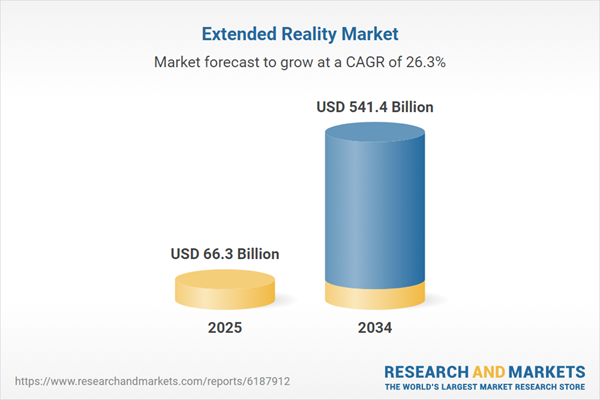Extended Reality Market Overview
The extended reality (XR) market, encompassing virtual reality (VR), augmented reality (AR), and mixed reality (MR), is experiencing significant growth as businesses and consumers adopt immersive technologies for diverse applications. Industries such as gaming, healthcare, education, retail, and manufacturing are increasingly leveraging XR to enhance user experiences, improve training methodologies, and streamline operations. The rapid evolution of 5G networks, AI-driven spatial computing, and advanced hardware capabilities has accelerated XR adoption. Companies are investing in XR to develop new digital experiences, ranging from virtual shopping environments to interactive workplace collaboration tools. The growing demand for metaverse-related applications is also fueling investment in XR development. However, challenges such as high hardware costs, data privacy concerns, and content creation barriers remain obstacles to widespread adoption. As technological advancements continue, XR is set to revolutionize digital interactions across multiple sectors, unlocking new opportunities for innovation and engagement.the XR market has witnessed notable advancements in both hardware and software capabilities. The launch of next-generation XR headsets with enhanced resolution, improved field of view, and AI-powered gesture tracking has significantly enhanced user experiences. Enterprise adoption of XR has surged, particularly in remote collaboration, employee training, and industrial simulations. The healthcare sector has seen increased use of XR for surgical simulations, mental health therapy, and medical training. The retail industry has embraced AR-powered shopping experiences, allowing customers to visualize products in real-time before purchase. Additionally, the gaming sector has continued to push the boundaries of immersive entertainment with hyper-realistic VR environments and multiplayer metaverse integrations. Cloud-based XR solutions have also gained traction, enabling lightweight, high-performance XR applications without reliance on expensive hardware. As major technology firms continue to invest in XR, strategic partnerships and acquisitions are driving innovation in content creation, user interfaces, and AI-powered experiences.
The XR market is expected to undergo a transformative shift, driven by advancements in artificial intelligence, brain-computer interfaces, and seamless integration with smart wearables. The convergence of XR with the Internet of Things (IoT) and edge computing will enable real-time spatial interactions, enhancing applications in digital twin simulations and smart cities. XR-powered training programs will become mainstream in industries such as defense, construction, and aviation, reducing training costs and improving operational efficiency. Consumer adoption will accelerate as hardware costs decrease, and standalone XR devices become more affordable and lightweight. The metaverse will evolve with deeper integration of XR-driven social and business interactions, transforming virtual workplaces, remote collaboration, and digital commerce. Governments and regulatory bodies will introduce new frameworks to address concerns related to privacy, ethical AI use, and digital identity security in XR environments. As the ecosystem matures, the extended reality market will redefine human-computer interactions, opening the door to an entirely new dimension of immersive digital experiences.
Key Insights: Extended Reality Market
- AI-Driven Spatial Computing: Artificial intelligence is enhancing XR experiences by enabling real-time object recognition, gesture-based interactions, and adaptive virtual environments, improving user immersion and functionality.
- XR-Powered Workplace Collaboration: Businesses are leveraging XR for virtual meetings, 3D model visualizations, and remote training, transforming the way teams interact and work in hybrid environments.
- Advancements in Lightweight and Affordable XR Devices: The development of energy-efficient, lightweight headsets with improved battery life and affordability is driving mass adoption in both consumer and enterprise markets.
- Cloud-Based XR Solutions: Cloud computing is reducing the dependency on high-end hardware by enabling cloud-streamed XR applications, making extended reality experiences more accessible and scalable.
- Integration of XR in Healthcare and Therapy: XR applications in healthcare are expanding, including pain management, cognitive rehabilitation, exposure therapy, and patient education, enhancing medical treatment outcomes.
- Growth of 5G Networks for Seamless XR Experiences: The expansion of 5G infrastructure is enabling high-speed, low-latency XR applications, improving real-time rendering and streaming capabilities.
- Rising Demand for Immersive Learning and Training Solutions: Enterprises and educational institutions are increasingly adopting XR-powered simulations and virtual classrooms to enhance engagement and knowledge retention.
- Expansion of the Metaverse and Digital Commerce: The push towards metaverse development is driving investment in XR-based social interactions, digital asset trading, and virtual economies.
- Increasing Investments in XR Startups and Innovation: Venture capital funding and corporate investments in XR technology are fueling innovation in hardware, software, and content creation.
- High Development Costs and Content Creation Challenges: XR content production remains expensive and complex, requiring significant investment in 3D modeling, real-time rendering, and interactive storytelling, which limits widespread adoption across smaller businesses.
Extended Reality Market Segmentation
By Component
- Hardware
- Software
- Services
By Technologies
- Augmented Reality (AR) Technology
- Virtual Reality (VR) Technology
- Mixed Reality (MR) Technology
By End User
- Gaming
- Retail
- Healthcare
- Manufacturing
- Media and Entertainment
- Education
- Aerospace and Defense
- Other End Users
Key Companies Analysed
- Apple Inc.
- Google LLC
- Samsung Electronics Co. Ltd.
- Microsoft Corporation
- Meta Platforms Inc.
- Sony Corporation
- Accenture plc
- Qualcomm Incorporated
- NVIDIA Corporation
- Adobe Inc.
- Seiko Epson Corporation
- Dassault Systemes SE
- PTC Inc.
- Unity Technologies Inc
- SoftServe Inc.
- Tata Elxsi Ltd.
- Semcon AB
- HTC Corporation
- Northern Digital Inc.
- Varjo Technologies Oy
- Talespin Reality Labs Inc.
- Ultraleap Ltd
- Marxent Labs LLC
- Vuzix Corporation
- Avegant Corporation
- Virtuix Inc.
- Worldviz LLC
- Sixense Enterprises Inc.
- Daqri LLC
- The Void LLC
Extended Reality Market Analytics
The report employs rigorous tools, including Porter’s Five Forces, value chain mapping, and scenario-based modeling, to assess supply-demand dynamics. Cross-sector influences from parent, derived, and substitute markets are evaluated to identify risks and opportunities. Trade and pricing analytics provide an up-to-date view of international flows, including leading exporters, importers, and regional price trends.Macroeconomic indicators, policy frameworks such as carbon pricing and energy security strategies, and evolving consumer behavior are considered in forecasting scenarios. Recent deal flows, partnerships, and technology innovations are incorporated to assess their impact on future market performance.
Extended Reality Market Competitive Intelligence
The competitive landscape is mapped through proprietary frameworks, profiling leading companies with details on business models, product portfolios, financial performance, and strategic initiatives. Key developments such as mergers & acquisitions, technology collaborations, investment inflows, and regional expansions are analyzed for their competitive impact. The report also identifies emerging players and innovative startups contributing to market disruption.Regional insights highlight the most promising investment destinations, regulatory landscapes, and evolving partnerships across energy and industrial corridors.
Countries Covered
- North America - Extended Reality market data and outlook to 2034
- United States
- Canada
- Mexico
- Europe - Extended Reality market data and outlook to 2034
- Germany
- United Kingdom
- France
- Italy
- Spain
- BeNeLux
- Russia
- Sweden
- Asia-Pacific - Extended Reality market data and outlook to 2034
- China
- Japan
- India
- South Korea
- Australia
- Indonesia
- Malaysia
- Vietnam
- Middle East and Africa - Extended Reality market data and outlook to 2034
- Saudi Arabia
- South Africa
- Iran
- UAE
- Egypt
- South and Central America - Extended Reality market data and outlook to 2034
- Brazil
- Argentina
- Chile
- Peru
Research Methodology
This study combines primary inputs from industry experts across the Extended Reality value chain with secondary data from associations, government publications, trade databases, and company disclosures. Proprietary modeling techniques, including data triangulation, statistical correlation, and scenario planning, are applied to deliver reliable market sizing and forecasting.Key Questions Addressed
- What is the current and forecast market size of the Extended Reality industry at global, regional, and country levels?
- Which types, applications, and technologies present the highest growth potential?
- How are supply chains adapting to geopolitical and economic shocks?
- What role do policy frameworks, trade flows, and sustainability targets play in shaping demand?
- Who are the leading players, and how are their strategies evolving in the face of global uncertainty?
- Which regional “hotspots” and customer segments will outpace the market, and what go-to-market and partnership models best support entry and expansion?
- Where are the most investable opportunities - across technology roadmaps, sustainability-linked innovation, and M&A - and what is the best segment to invest over the next 3-5 years?
Your Key Takeaways from the Extended Reality Market Report
- Global Extended Reality market size and growth projections (CAGR), 2024-2034
- Impact of Russia-Ukraine, Israel-Palestine, and Hamas conflicts on Extended Reality trade, costs, and supply chains
- Extended Reality market size, share, and outlook across 5 regions and 27 countries, 2023-2034
- Extended Reality market size, CAGR, and market share of key products, applications, and end-user verticals, 2023-2034
- Short- and long-term Extended Reality market trends, drivers, restraints, and opportunities
- Porter’s Five Forces analysis, technological developments, and Extended Reality supply chain analysis
- Extended Reality trade analysis, Extended Reality market price analysis, and Extended Reality supply/demand dynamics
- Profiles of 5 leading companies - overview, key strategies, financials, and products
- Latest Extended Reality market news and developments
Additional Support
With the purchase of this report, you will receive:- An updated PDF report and an MS Excel data workbook containing all market tables and figures for easy analysis.
- 7-day post-sale analyst support for clarifications and in-scope supplementary data, ensuring the deliverable aligns precisely with your requirements.
- Complimentary report update to incorporate the latest available data and the impact of recent market developments.
This product will be delivered within 1-3 business days.
Table of Contents
Companies Mentioned
- Apple Inc.
- Google LLC
- Samsung Electronics Co. Ltd.
- Microsoft Corporation
- Meta Platforms Inc.
- Sony Corporation
- Accenture PLC
- Qualcomm Incorporated
- NVIDIA Corporation
- Adobe Inc.
- Seiko Epson Corporation
- Dassault Systemes SE
- PTC Inc.
- Unity Technologies Inc.
- SoftServe Inc.
- Tata Elxsi Ltd.
- Semcon AB
- HTC Corporation
- Northern Digital Inc.
- Varjo Technologies Oy
- Talespin Reality Labs Inc.
- Ultraleap Ltd.
- Marxent Labs LLC
- Vuzix Corporation
- Avegant Corporation
- Virtuix Inc.
- Worldviz LLC
- Sixense Enterprises Inc.
- Daqri LLC
- The Void LLC
Table Information
| Report Attribute | Details |
|---|---|
| No. of Pages | 160 |
| Published | October 2025 |
| Forecast Period | 2025 - 2034 |
| Estimated Market Value ( USD | $ 66.3 Billion |
| Forecasted Market Value ( USD | $ 541.4 Billion |
| Compound Annual Growth Rate | 26.2% |
| Regions Covered | Global |
| No. of Companies Mentioned | 30 |









